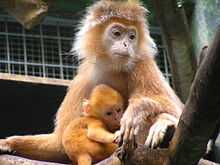Javan lutung
| Javan lutung[1] | |
|---|---|
 | |
| Conservation status | |
| Scientific classification | |
| Kingdom: | Animalia |
| Phylum: | Chordata |
| Class: | Mammalia |
| Order: | Primates |
| Family: | Cercopithecidae |
| Genus: | Trachypithecus |
| Species group: | T. cristatus |
| Species: | T. auratus |
| Binomial name | |
| Trachypithecus auratus É. Geoffroy, 1812 | |
 | |
| Javan lutung range (green — native, dark gray — origin uncertain) | |
The Javan lutung (Trachypithecus auratus),[1] also known as the ebony lutung and Javan langur, is an Old World monkey from the Colobinae subfamily. It is most commonly glossy black with a brownish tinge to its legs, sides, and "sideburns".[3] It is found on and endemic to the island of Java, as well as on several of the surrounding Indonesian islands. The Latin word auratus in its scientific name means "golden", and refers to a less common color variant. Note that the common name golden langur is used for a different species.
Like all langurs, this species' tail is noticeably long, measuring up to 98 cm in length while the body is only around 55 cm long.[4] The two subspecies of this lutung are fairly similar in appearance and are geographically separated; males and females are both usually glossy black, although the females pale, yellowish white patch around the pubic area. Juveniles of both subspecies are orange in color.[5] The nominate subspecies Trachypithecus auratus auratus has a rare race that does not lose its juvenile coloration when it matures, instead the coloration darkens slightly, with yellow tinges on its sides, limbs, and around its ears, and a black tinge on its back.[3]
The Javan lutung inhabits the interior and peripheral areas of rainforests.[3]
This primate is diurnal and arboreal.[3] Its diet is primarily herbivorous, eating leaves, fruit, flowers, and flower buds, although it also eats insect larvae. As with other colobines, it has evolved a specialised stomach to digest plant material more efficiently.[4] This species also has enlarged salivary glands to assist it in breaking down food.[3]
Like other langurs, the Javan lutung is a social animal, living in groups of around seven individuals, with one or two adult males in the group.[3] Although they will look after offspring of other mothers as well as their own, adult females are aggressive towards females from other groups. The brighter coloring of juveniles may alert females to their presence and ensures that they will always be noticed and protected.[3][4] This species has no discernible mating season and females produce one offspring at a time.[3]
Subspecies
- Eastern Javan lutung or spangled ebony lutung, Trachypithecus auratus auratus
- Western Javan lutung, Trachypithecus auratus mauritius
Roos et al., 2008, elevated T. a. mauritius to species-level as Trachypithecus mauritius.[6]
Gallery
-

Javan lutung Trachypithecus auratus auratus (light race) in Bristol zoo
-

Javan lutung Trachypithecus auratus auratus (light race) Twycross Zoo, August 2006
-

Twycross zoo
-
Group, Zoo Hannover, Germany
References
| Wikimedia Commons has media related to Trachypithecus auratus. |
- ↑ 1.0 1.1 Groves, C. P. (2005). Wilson, D. E.; Reeder, D. M, eds. Mammal Species of the World (3rd ed.). Baltimore: Johns Hopkins University Press. p. 175. OCLC 62265494. ISBN 0-801-88221-4.
- ↑ Nijman, V. & Supriatna, J. (2008). Trachypithecus auratus. In: IUCN 2008. IUCN Red List of Threatened Species. Retrieved 4 January 2009.
- ↑ 3.0 3.1 3.2 3.3 3.4 3.5 3.6 3.7 "Primate Fact Sheets". October 15, 2003. Retrieved January 2004.
- ↑ 4.0 4.1 4.2 Macdonald, D. (2001). The New Encyclopedia of Mammals. Oxford: Oxford University Press.
- ↑ Rowe, N. (1996). The Pictorial Guide to the living Primates. East Hampton, New York: Pogonias Press.
- ↑ Roos, C. et al. (2008). "Mitochondrial phylogeny, taxonomy and biogeography of the silvered langur species group (Trachypithecus cristatus)". Molecular Phylogenetics and Evolution 47 (2): 629–636. doi:10.1016/j.ympev.2008.03.006. PMID 18406631.



